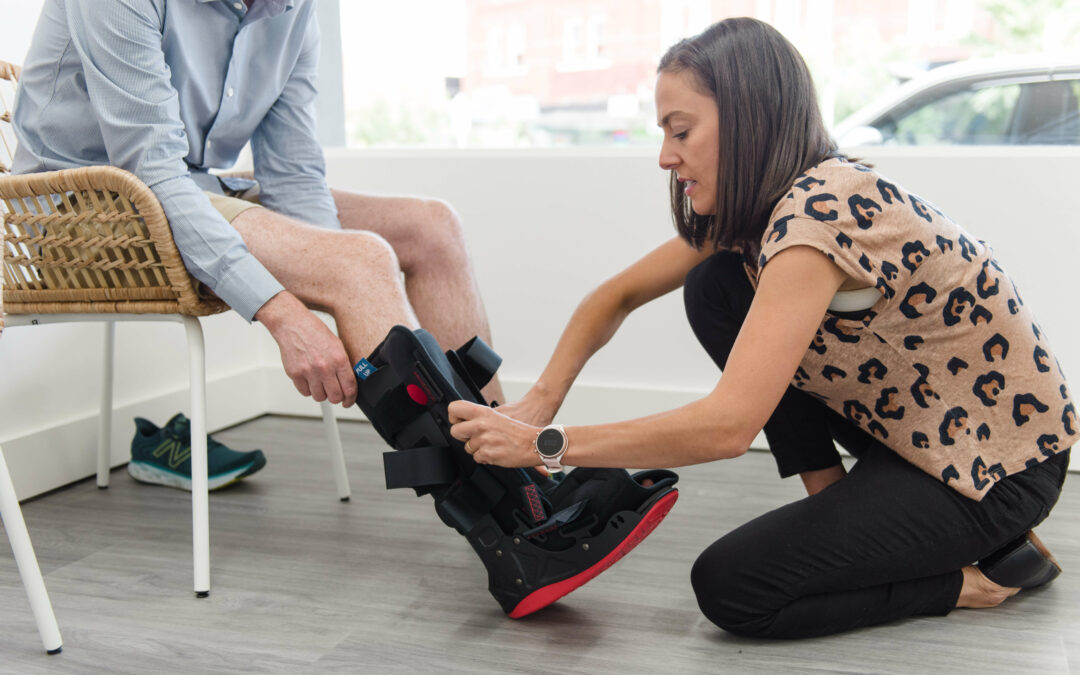A moon boot, also known as a walker or cast boot, is a crucial medical device used to support and protect the foot and leg after an injury such as a fracture, sprain, or surgery. While it may limit mobility to promote healing, wearing a moon boot doesn’t mean you have to be immobilised during your recovery. In fact, with the right tips and moon boot fittings, you can still walk and move around without putting too much strain on your injured limb. The key is to understand how to use the moon boot properly for doability in walking. By following expert advice from healthcare professionals on proper usage of the moon boot, you can learn how to walk safely while wearing it. This will help prevent further damage while allowing for some level of mobility during your recovery period.
It’s important to know that using a moon boot does not necessarily mean complete immobility; rather, it provides necessary support and protection for your injured foot or leg. With the right knowledge and understanding of its purpose and functionality, you can continue moving about without causing harm or discomfort. So if you find yourself needing a moon boot after an injury that immobilises your lower limb, don’t worry – with the right guidance and precautions in place – you’ll still be able to maintain some level of activity while ensuring proper healing from your injury.
You can do various exercises in a moon boot to maintain your physical fitness, prevent muscle atrophy, and promote overall well-being.
- Seated Exercises
Seated exercises are an excellent starting point for individuals in a moon boot. These exercises help maintain upper body strength and cardiovascular fitness while minimising strain on the injured leg.
a. Seated Arm Circles: Sit on a stable surface like a chair and extend your arms to the sides. Make slow, controlled circles with your arms, gradually increasing the range of motion as you progress.
b. Seated Leg Lifts: While seated, raise your uninjured leg straight out in front of you, holding for a few seconds before lowering it. This exercise strengthens the hip flexors and quadriceps without putting pressure on the injured leg. You can also do this with your injured leg, but be aware that the boot will add weight to that limb, so reducing repetitions may be required.
c. Seated Marches: Sit upright with good posture and alternate lifting your knees toward your chest in a marching motion. This exercise improves circulation and maintains lower abdominal strength.
- Upper Body Workouts
When one leg is immobilised in a moon boot, it’s essential to focus on your upper body strength and stability. There are various upper body exercises you can incorporate into your routine:
a. Push-Ups: Perform modified push-ups on your knees or against a wall to strengthen your chest, shoulders, and triceps.
b. Dumbbell Exercises: If you can access light dumbbells, you can perform seated bicep curls, shoulder presses, and lateral raises to target your upper body muscles.
c. Resistance Bands: Resistance bands offer a versatile way to work on your upper body. You can do exercises like seated rows, bicep curls, and triceps extensions with them.
- Core Strengthening
Maintaining a strong core can help improve balance and stability, essential when wearing a moon boot. Try these core exercises:
a. Seated Leg Raises: Sit on the edge of a chair with your back straight and lift your uninjured leg as high as possible while keeping it straight. Hold for a few seconds and lower it back down. Repeat for several sets.
b. Seated Twists: Sit on a stable surface and hold a medicine ball or a dumbbell. Twist your torso to the right and then to the left, engaging your core muscles as you do so.
c. Planks: While your injured leg remains immobilised, you can still do planks to strengthen your core muscles. Perform forearm planks or side planks to engage different core muscle groups.
- Cardiovascular Activities
Maintaining cardiovascular fitness during recovery is crucial for overall health. Even with a moon boot, you can engage in low-impact cardiovascular activities:
a. Swimming: If your injury allows, swimming is an excellent option. It provides a full-body workout while minimising stress on your injured leg.
b. Stationary Cycling: Use a stationary bike with the moon boot removed, if possible, or with your injured leg propped up. Adjust the resistance to control the intensity of your workout.
c. Arm Ergometer: An arm ergometer is a specialised piece of equipment that allows you to engage in a seated upper body workout that simulates cycling. It’s perfect for maintaining cardiovascular fitness without involving the lower body.
- Mind-Body Activities
Recovery from an injury can be mentally challenging, so incorporating mind-body activities can help you stay positive and reduce stress.
a. Yoga and Meditation: Engaging in seated yoga and mindfulness meditation can help you relax, improve your mental well-being, and reduce anxiety during recovery.
b. Tai Chi: This gentle martial art can be adapted for seated practice. Tai Chi promotes balance, flexibility, and relaxation.
c. Deep Breathing: Deep breathing exercises can help reduce pain perception and promote relaxation.
Conclusion
While wearing a moon boot, recovering from a lower limb injury doesn’t mean you must give up on staying active and fit. You can do numerous exercises and activities to maintain your physical and mental well-being during this challenging time. Remember to consult your podiatrist, healthcare provider or physical therapist before starting any new exercise routine to ensure it is safe and appropriate for your condition. With dedication, patience, and guidance, you can make the most out of your moon boot recovery period and emerge stronger and healthier.

